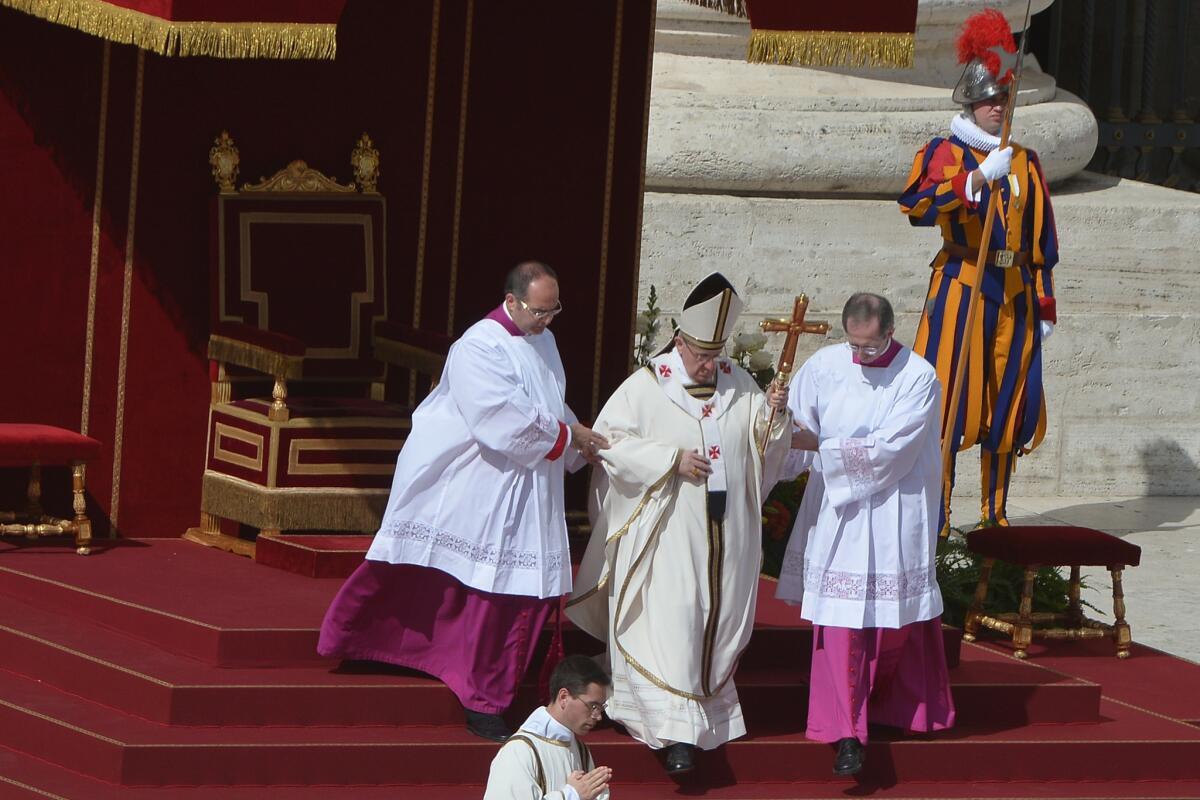The pope dresses down -- and what it means

- Share via
Five years ago I wrote an op-ed column for The Times about Pope Benedict XVI’s partiality for ornate vestments and miters (the double-pointed hats sported not only by the pope but also by other bishops in the Roman Catholic and Anglican churches). That article, which a clever copy editor titled “Dress Code,” is looking more and more like a period piece after the inaugural Mass of Benedict’s successor, Pope Francis.
In what must have been a disappointment to Msgr Guido Marini, the papal “master of ceremonies” who outfitted Benedict in skyscraper jeweled miters and elaborately embroidered chasubles, Francis dressed down at a ceremony that was a far cry from the formality of Benedict’s inaugural Mass, let alone the coronations with which popes began their pontificate before Pope John Paul I junked the tiara in 1978.
The pope wore a miter, but it seems to be the same unadorned model he used in Argentina. (My guess is that the new archbishop of Canterbury, an Evangelical Anglican who will be enthroned this week, will wear a more ornate miter than Francis’.) The pope’s chasuble, the poncho-like vestment used by priests celebrating Mass, was similarly simple – less elaborately decorated, in fact, than the one worn by cardinals in attendance. And it followed the “Gothic” style popular after the second Vatican Council (and also employed by some Protestant churches), not the stiff “Roman” style Benedict revived.
Why does this matter? There’s a reason conservative Roman Catholics have been grumbling online about Francis’ sartorial understatement, first evident when he showed up on the balcony after his election not wearing the ermine-lined red garment known as a mozzetta. There really is a “dress code” at work here. By choosing to wear simpler vestments, the new pope is not only disdaining pomp; he is signaling that he is comfortable with the liturgical style of post-Vatican II Catholicism. That is an ominous sign for “rad trads” – so-called radical traditionalist Catholics who delighted in the fact that Benedict pushed back against post-Vatican II developments such as simpler vestments, the use of vernacular and the practice of priests facing the congregation during Mass.
These controversies might seem to involve only aesthetics, but there is an old Latin saying in the church: “Lex orandi, lex credendi” – which, loosely translated, means that the law of prayer is the law of belief. Elaborate vestments for the clergy emphasize the difference between the ordained clergy and the laity, a gap that began to close after Vatican II. Likewise disputes over whether the priest faces the congregation or whether believers receive Communion in the hand or on the tongue reflect different theological views about the nature of the sacrament. Benedict was clearly in the traditionalist camp on these questions; Francis’ fashion choices suggest at least the possibility that he sees things differently.
ALSO:
Photo gallery: Ted Rall cartoons
A new pope and the remodeling of the world’s moral map
Slide show: 10 reasons to salute L.A.’s transportation future
More to Read
A cure for the common opinion
Get thought-provoking perspectives with our weekly newsletter.
You may occasionally receive promotional content from the Los Angeles Times.











